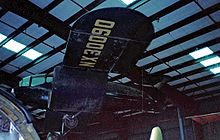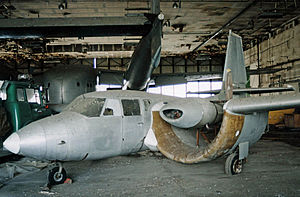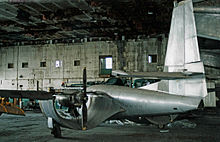- Custer Channel Wing
-
CCW-5 Channel Wing Front view of the second CCW-5 preserved by the Mid-Atlantic Air Museum in Reading, Pennsylvania Role Experimental aircraft National origin United States Manufacturer Custer Channel Wing Corporation Designer Willard Ray Custer First flight 13 July 1953 Introduction 1953 Status preserved in a museum Produced 1953-1964 Number built 2 Developed from CCW-1 Channel Wing The Custer Channel Wing was a series of American-built experimental aircraft designs of the 1940s and 1950s incorporating a half-barrel shaped section to each wing.
Contents
Initial design
Willard Custer filed a United States patent in 1929 for a wing design incorporating a semi-circular channel or "half barrel" shape in which an engine was to be fitted in pusher mode. Custer claimed that this layout, the channel wing, which gave STOL operating capabilities, resulted in a design "which is an aircraft not an airplane. It does not plane the air to fly, rather it brings the air to the lift surfaces and reduces pressure to fly at 8 to 11 mph"[1]
Development
CCW-1
 The prototype Custer CCW-1 single-seat test aircraft displayed at the National Air and Space Museum facility at Silver Hill, Maryland in April 1982
The prototype Custer CCW-1 single-seat test aircraft displayed at the National Air and Space Museum facility at Silver Hill, Maryland in April 1982
The first aircraft to incorporate Custer's concept was the CCW-1 which was fitted with a single-seat and was powered by two 75 h.p. Lycoming O-145 pusher engines. Registered NX30090 the sole example first flew on 12 November 1942 during a solo flight that was quite unintentional. Custer, who was a non-pilot, taxied the aircraft in a demonstration for financial backers and it suddenly became airborne. A hard landing followed, and one landing gear collapsed, but this did not dampen his backers' enthusiasm. [1] This aircraft is preserved in the National Air and Space Museums store at Silver Hill, Maryland.[2]
CCW-2
This was an evolution of the CCW-1 as a single-seat test bed and used an adapted uncovered fuselage of a Taylorcraft BC-12 light aircraft, replacing the single engine with two pusher engines fitted each side of the fuselage and placed within the wing channels.[3] The sole example N1375V first flew on 3 July 1948. It was flown for about 100 hours of testing with take-off and landing being made within 45-65 ft. Despite the claim of "flying better than a conventional aircraft" it was calculated that a stock Piper Cub was more efficient, lifting 18 lbs/h.p. versus the CCW-2s 11 lbs/h.p.[1] The CCW-3 and CCW-4 designations were not used.
CCW-5
Main article: Custer CCW-5During the early 1950s, Custer formed the Custer Channel Wing Corporation to develop and build the five-seat CCW-5 design which was intended for commercial sale. The first example N6257C was designed by Custer but built by the Baumann Corporation of Santa Barbara, California. It utilised an adapted fuselage and tail assembly of a Baumann Brigadier. Power was from two pusher 225 h.p. Continental O-470 engines. The first flight was made on 13 July 1953.[1].
Custer persisted with his design and built the second example N5855V at the Custer Channel Wing Corp factory. It again used a Baumann Brigadier fuselage and tail assembly. Although several firms expressed interest in production of the design, all failed to provide sufficient funds. This aircraft first flew on 19 June 1964.[1]
The CCW-5 accommodated five persons, and its power plants are suspended in the centre of the 6ft-chord wing channels on tubular frameworks attached to the wing spars. The aircraft draws air through the channels at high velocity, decreasing pressure over the wings and increasing lift. The CCW-5 was claimed to be capable of flying at a sustained speed of 35 mph.[4] Production deliveries were scheduled to commence during 1965, but this was never achieved.
Operational history
The CCW-5 continued to make developments flights during the 1960s and 1970s, but no production orders were obtained. The second example was donated to the Mid-Atlantic Air Museum at Reading Airport, Pennsylvania and is on restricted display. [5]
Specifications (CCW-5)
Data from Green, 1965, p.223
General characteristics
- Crew: 1
- Capacity: 4 passengers
- Length: 28 ft 8 in (8.74 m)
- Wingspan: 41 ft 2 in (12.55 m)
- Height: 10 ft 10 in (3.30 m)
- Empty weight: 3,675 lb (1,667 kg)
- Gross weight: 4,925 lb (2,234 kg)
- Max takeoff weight: 5,400 lb (2,449 kg)
- Powerplant: 2 × Continental IO-470-D piston, 260 hp (190 kW) each
Performance
- Maximum speed: 200 mph (320 km/h; 170 kn)
- Cruise speed: 180 mph (160 kn; 290 km/h)
- Range: 1,150 mi (999 nmi; 1,851 km)
- Service ceiling: 22,000 ft (6,706 m)
- Rate of climb: 2,500 ft/min (13 m/s)
See also
Notes
References
- "The Channel Wing.". Flight International (4 January 1952): p.14. http://www.flightglobal.com/pdfarchive/view/1952/1952%20-%200044.html.
External links
- Aerofiles.com: Data and photographs of the CCW series
- Information and photographs of the preserved CCW-5
Custer Channel Wing Corporation Aerodynamics Aircraft People Willard Ray CusterLists relating to aviation General Aircraft (manufacturers) · Aircraft engines (manufacturers) · Airlines (defunct) · Airports · Civil authorities · Museums · Registration prefixes · Rotorcraft (manufacturers) · TimelineMilitary Accidents/incidents Records Categories:- Channel-wing aircraft
- Custer aircraft
- United States experimental aircraft 1950–1959
- United States civil utility aircraft 1950–1959
Wikimedia Foundation. 2010.


